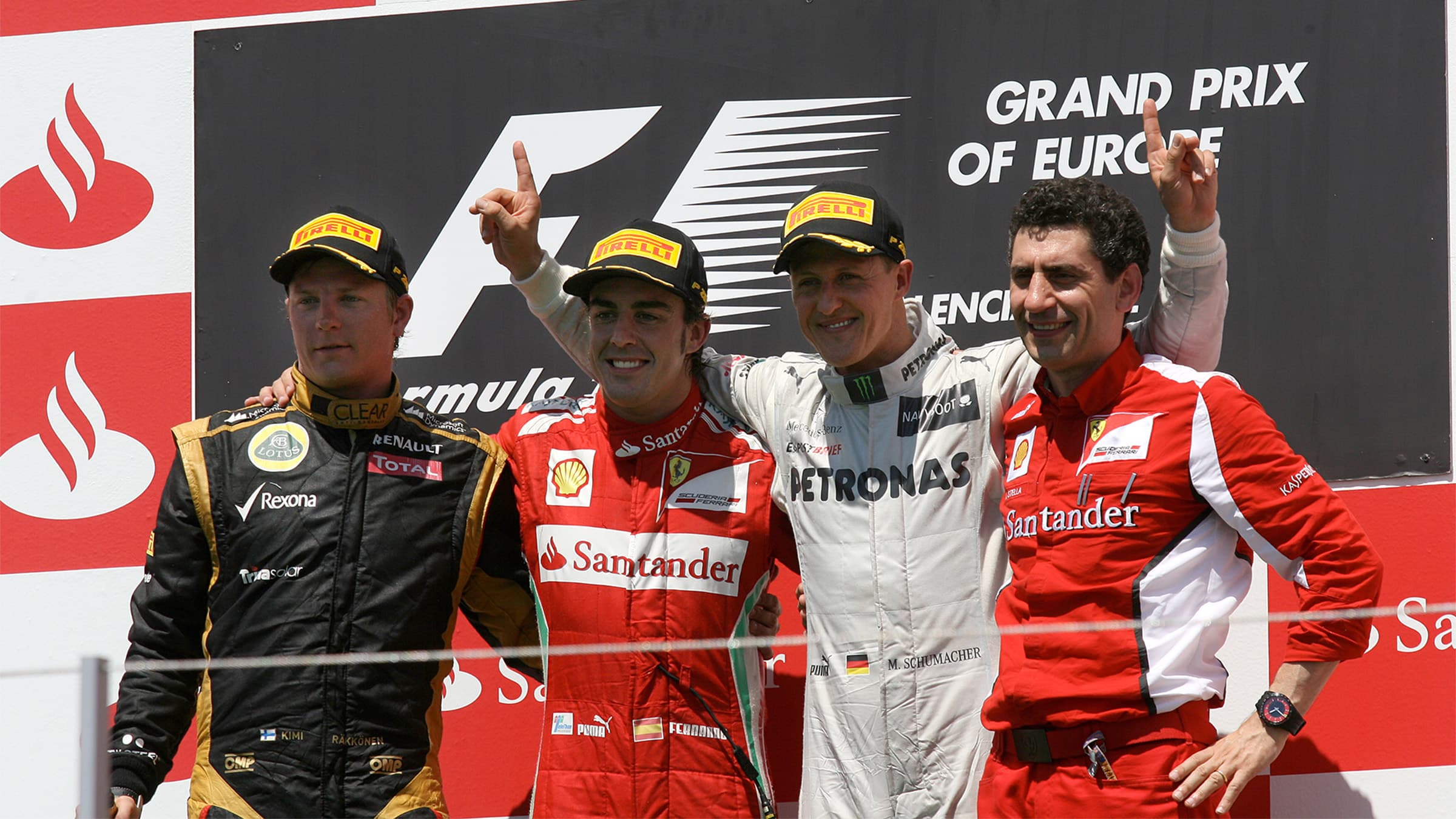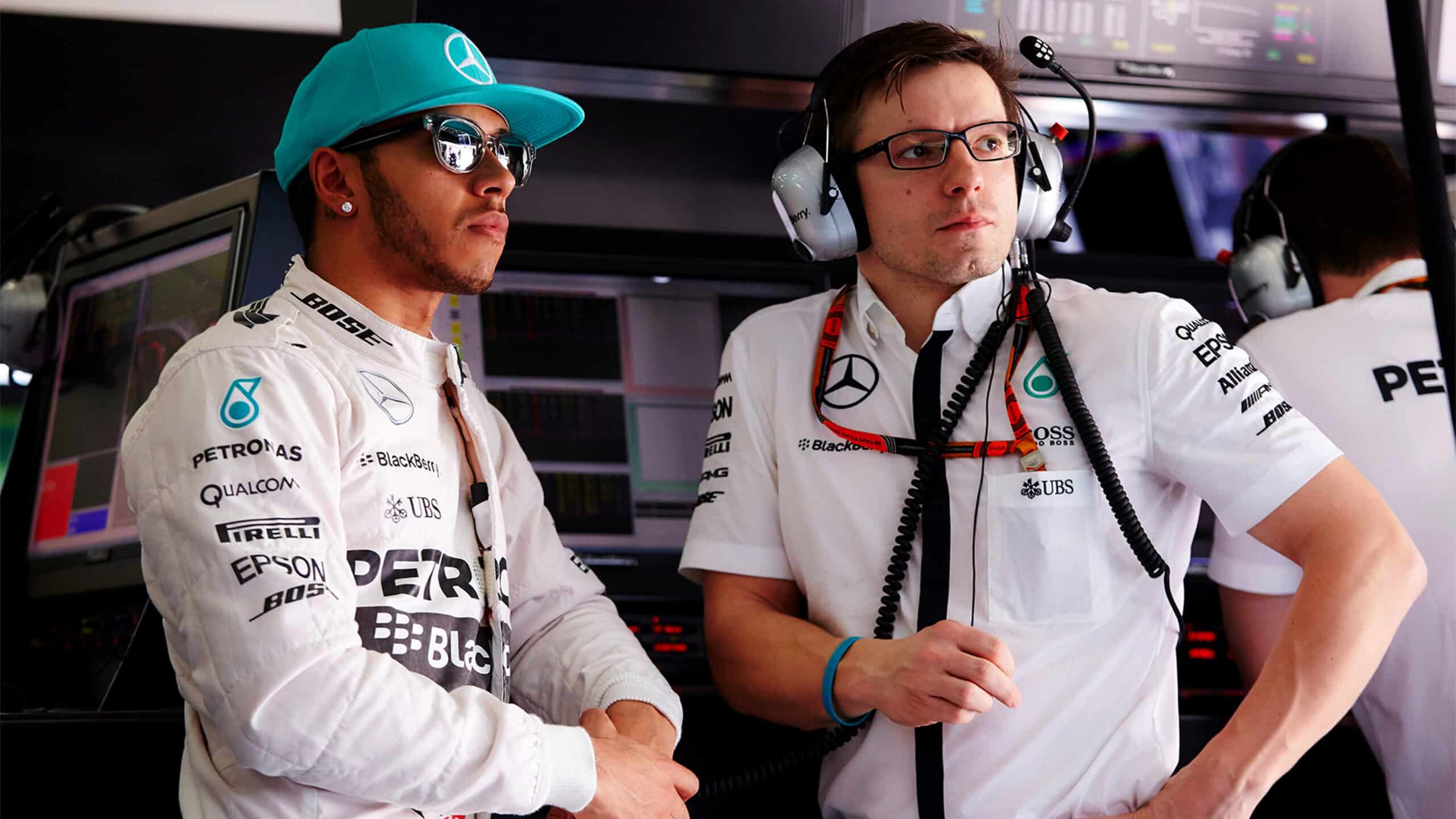Who is Bono in F1? Peter Bonnington, race engineer to two world champions
Everything you need to know about Mercedes' Peter 'Bono' Bonnington, including his early days in the F1 paddock with Jordan and his time as a race engineer to two seven-time world champions

Peter 'Bono' Bonnington and Lewis Hamilton have become perhaps the greatest race engineer/driver pairing of all time
Getty Images
Drivers may take a large share of the plaudits for Formula 1 success but by no means do they stand alone. Every driver in the modern era is dependent on their race engineer: — a voice of reason, logic and calculated knowledge, with a view of the overall race, and the strategies required to win. Mercedes‘ Peter Bonnington is among the very best of them.
He rose to fame with Lewis Hamilton, having been his race engineer since the driver joined Mercedes in 2013, with a hand in his six drivers’ championships with the team. During Mercedes’ era of dominance, fans became accustomed to Hamilton lapping at a blistering pace just before making a pitstop, triggered by the famous phrase, “Ok Lewis, it’s hammer time.”
However, Bonnington was a prominent figure in the paddock before his partnership with Hamilton. He’s raced with four F1 constructors’, been a part of nine world title-winning campaigns and become the only engineer to guide two seven-time world champions in a career that has spanned over two decades.
Following Hamilton’s move to Ferrari in 2025, there were suggestions that Bonnington could move with him to maintain the winning partnership. But the Briton later committed his future to Mercedes, and was announced as the team’s Head of Race Engineering midway through the 2024 campaign.
Peter Bonnington’s early F1 career
Bonnington first entered the F1 paddock in 2004, joining Jordan Grand Prix as a data engineer. In the midst of overwhelming Ferrari-led dominance, Jordan was a struggling outfit — in fact the team scored just five points across the season and finished ninth in the constructors’ standings. But it nevertheless provided a great learning opportunity for a young ‘Bono’ whose role generally involved analysing performance data, as well as calibrating and logging different vehicle systems such as the gear shift lights and throttle maps.
Another year of struggle for the Jordan team in 2005 was to be its last on an F1 grid, as the team was sold during the winter break and later became the Midland F1 team — an equally underperforming force in the F1 pitlane. But luckily for Bonnington, he managed to escape the collapse of Jordan and the subsequent frustration of running as a backmarker as he signed to be a performance engineer with Honda from 2006 onwards. Here, he began as an understudy to Andrew Shovlin — who would later become Mercedes’ engineering director — and partnered with a young Jenson Button.
Working alongside Button’s race enginner, Bonnington’s role was to analyse driver data and ensure that the car was set-up correctly for each session. This included monitoring ride heights, tyre pressures, and suspension changes while also making suggestions on optimum braking points and overtaking zones. The bond between the pair grew exponentially over their first season together, in which Button marked himself as a future world champion for the first time: scoring podium finishes in Malaysia and Brazil as well as a single victory at Hungary and eight other point-scoring appearances which eventually secured sixth in the drivers’ standings.
Unfortunately, ’06 would be remembered as Honda’s F1 peak as the team found progressively less performance in ‘07 and ‘08 — with just 20 points scored over both seasons.
Winning with Brawn

From left to right: Bono stands on the podium beside Mark Webber, Jenson Button and Sebastian Vettel at 2009 Turkish Grand Prix
Grand Prix Photo
Bonnington saw another change of scenery ahead of the 2009 campaign, as Honda was bought by former Ferrari boss Ross Brawn and was renamed Brawn GP. Button and Rubens Barrichello remained on as drivers, and the team hit the ground running under new regulations which shook up the running order of the grid. Suddenly, an outfit which had grown accustom to life in the midfield was winning races by significant margins, and Bono remained at the centre of it all as one of Button’s right hand men.
By seasons end in Abu Dhabi, Button had been crowned world champion with Brawn also taking home the constructors’ title too.
“You really need to build up a rapport with your engineer,” Button told Autosport while looking back on the season. “You can be the best engineer or the best driver in the world, but if you don’t understand each other it is not going to work.”
Mercedes
Ahead of 2010, Brawn were sold during the off-season to make way for the return of Mercedes — ending a 55-year hiatus away from F1. The team brought with them new management and new drivers: former seven-time world champion Michael Schumacher lining up alongside Nico Rosberg (son of F1 world champion Keke).
Nevertheless, Bonnington remained at Brackley but took on a new role as assistant race engineer to Schumacher — aiding in car set-ups as well as driver coaching. Despite the German’s legendary stature, his performance wasn’t quite at the level many may have expected as he failed to outpoint Rosberg in consecutive seasons from 2010 to 2012. Even so, Bonnington’s role within the team continued to grow and he became Schumacher’s official race engineer in September 2011 following the departure of Mark Slade.
Although he’d never win a race with the F1 legend, Bonnington did oversee several key performances as Schumacher wound down toward his second retirement — with a final podium at the 2012 European Grand Prix arguably being the best moment the pair shared.

With Bono in his ear, Schumacher stood on the podium for the final time in 2012
Grand Prix Photo
But then came the arrival of Lewis Hamilton — a driver who would join Mercedes in 2013 and create a lasting and overwhelmingly successful bond with Bonnington which has thrived to this day.
“It felt like he was a rock star walking in,” Bono told Sky Sports F1. “Looking back at the pictures, you just think, ‘Wow, this is Lewis’. Michael was such a legend, a great driver to have worked with. And then Lewis comes along and you think, this is the next breed. He’s here and he’s the rock star – and I’m the one in charge!”
A semi-shaky start in 2013 — in which Hamilton claimed only one race victory — would be the pairing’s least successful season for almost a decade, with Hamilton at the wheel and Bono in his ear. When new engine regulations took ahold of the series in 2014, Mercedes rose to power and across the next eight seasons, the Briton’s would secure 80 race victories, 71 pole positions and six drivers’ world titles. It remains the most successful driver and race engineer pairing in F1 history.
They also grew to fame together through the use of the phrase “It’s hammer time” which was first introduced by Bonnington in order to tell Hamilton up his pace and use all the remaining tyre he has left.
“I’m incredibly grateful for Bono,” Hamilton told Sky Sports F1. “I’ve had an amazing journey with him, I think we’ve got one of the longest, if not the longest standing driver-engineer partnerships that there’s been, and he’s been hugely integral to my success.
“We’ve had an amazing journey together, we’ve supported each other on and off-track, through good and bad times, and I love working with Bono; he’s like a brother to me, a brother from another mother.
“I think he’s probably one of the few people that can truly stand me, I would say, on the good and bad days and how calm he’s able to be throughout a race, and how he’s able to help guide and help me navigate through a race. I don’t think there’s many people that can do that.”

Bono and Hamilton have been an almost inseparable team at Mercedes since 2013
Getty Images
What does an F1 race engineer do?
A race engineer’s job extends far beyond the pit wall and what you may see on TV. From the initial design and testing of the car through to practice, qualifying and race day, race engineers are tasked with the set-up of the car ahead of each session. Through analysing performance data and with one-on-one discussions with the drivers, they often act as the the sole link between what is happening on track and what is being done in the garage.
Radio systems allow race engineers to gain live feedback from the driver out on track ahead of competitive sessions. During qualifying they will be expected to warn the driver of any possible traffic around the circuit as well as communicate sector times and other general information the man in the cockpit may want to know. On race day, they will work closely with the race strategists and ensure that the driver knows when they should be coming into pit as well as gaining feedback on tyre life and warning them of potential problems the car may be having.
Peter Bonnington — F1 Career Overview
| Year | Team | Role |
| 2004 – 2005 | Jordan Grand Prix | Data Engineer |
| 2006 – 2008 | Honda | Performance Engineer |
| 2009 | Brawn GP | Data Engineer/Performance Engineer |
| 2010 – 2011 | Mercedes | Assistant Race Engineer |
| 2012 – 2024 | Mercedes | Race Engineer |
| 2024 – present | Mercedes | Head of Race Engineering |
